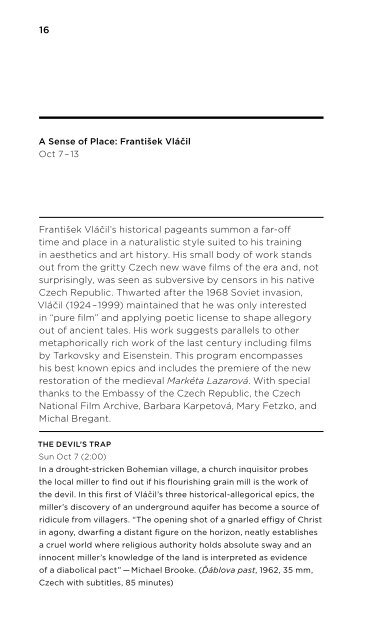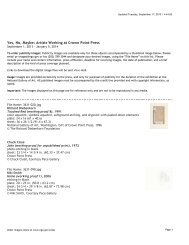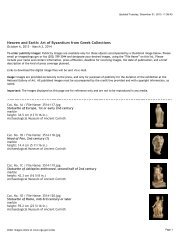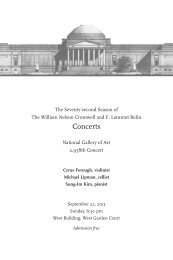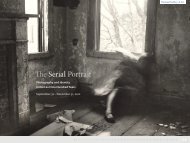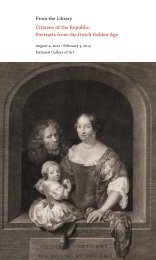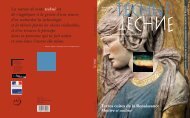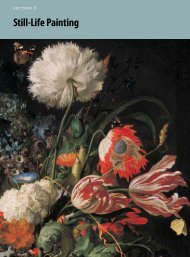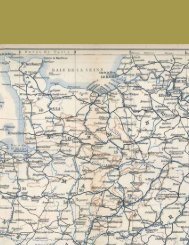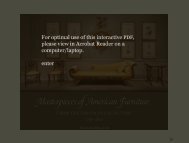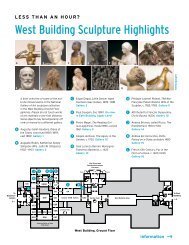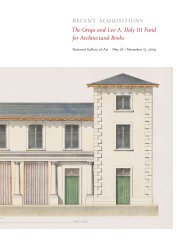Fall Film Calendar - National Gallery of Art
Fall Film Calendar - National Gallery of Art
Fall Film Calendar - National Gallery of Art
You also want an ePaper? Increase the reach of your titles
YUMPU automatically turns print PDFs into web optimized ePapers that Google loves.
16 17<br />
A Sense <strong>of</strong> Place: František Vláčil<br />
Oct 7 – 13<br />
František Vláčil’s historical pageants summon a far-<strong>of</strong>f<br />
time and place in a naturalistic style suited to his training<br />
in aesthetics and art history. His small body <strong>of</strong> work stands<br />
out from the gritty Czech new wave films <strong>of</strong> the era and, not<br />
surprisingly, was seen as subversive by censors in his native<br />
Czech Republic. Thwarted after the 1968 Soviet invasion,<br />
Vláčil (1924 – 1999) maintained that he was only interested<br />
in “pure film” and applying poetic license to shape allegory<br />
out <strong>of</strong> ancient tales. His work suggests parallels to other<br />
metaphorically rich work <strong>of</strong> the last century including films<br />
by Tarkovsky and Eisenstein. This program encompasses<br />
his best known epics and includes the premiere <strong>of</strong> the new<br />
restoration <strong>of</strong> the medieval Markéta Lazarová. With special<br />
thanks to the Embassy <strong>of</strong> the Czech Republic, the Czech<br />
<strong>National</strong> <strong>Film</strong> Archive, Barbara Karpetová, Mary Fetzko, and<br />
Michal Bregant.<br />
ThE DEVIl’S TRAP<br />
Sun Oct 7 (2:00)<br />
In a drought-stricken Bohemian village, a church inquisitor probes<br />
the local miller to find out if his flourishing grain mill is the work <strong>of</strong><br />
the devil. In this first <strong>of</strong> Vláčil’s three historical-allegorical epics, the<br />
miller’s discovery <strong>of</strong> an underground aquifer has become a source <strong>of</strong><br />
ridicule from villagers. “The opening shot <strong>of</strong> a gnarled effigy <strong>of</strong> Christ<br />
in agony, dwarfing a distant figure on the horizon, neatly establishes<br />
a cruel world where religious authority holds absolute sway and an<br />
innocent miller’s knowledge <strong>of</strong> the land is interpreted as evidence<br />
<strong>of</strong> a diabolical pact” — Michael Brooke. (Ďáblova past, 1962, 35 mm,<br />
Czech with subtitles, 85 minutes)<br />
MARKéTA lAzAROVá<br />
Premiere <strong>of</strong> the restoration<br />
Sun Oct 7 (4:30)<br />
One <strong>of</strong> only a handful <strong>of</strong> filmmakers who has ever tried to recreate<br />
the mood <strong>of</strong> medieval society, Vláčil based Markéta Lazarová on<br />
Vladislav Vančura’s best-selling 1931 novel, in turn based on a story<br />
handed down within Vančura’s family. Sets and costumes were even<br />
made with traditional tools, and actors tried to portray the raw and<br />
unfiltered emotions that presumably prevailed. Heroine Markéta,<br />
raped, kidnapped, and forced to serve an enemy clan, finds refuge<br />
in the orderliness <strong>of</strong> religion. Zdeněk Liška’s haunting musical score<br />
mixes vocal, percussive, and electronic motifs that beautifully buttress<br />
the narrative. This screening represents the American premiere<br />
<strong>of</strong> the latest restoration involving a complicated digital scan at<br />
4K resolution, followed by a painstaking cleanup <strong>of</strong> scratches and<br />
other damage to reinstate as closely as possible the original look <strong>of</strong><br />
the 35 mm film in the form <strong>of</strong> a new digital cinema print. (1967, DCP,<br />
Czech with subtitles, 180 minutes)<br />
ThE VAllEy OF ThE BEES<br />
Sat Oct 13 (2:00)<br />
From another novel by Vančura, The Valley <strong>of</strong> the Bees tells the<br />
odyssey <strong>of</strong> Ondřej, exiled as a child to a strict order <strong>of</strong> religious<br />
knights — his punishment after attempting to sabotage his father’s<br />
wedding. When Ondřej reaches maturity, he returns to his native village<br />
to seek retribution, even as his monk-guardian tries to bait him<br />
back to the order. In bold black-and-white Cinemascope, “Vláčil’s<br />
spectacular orchestration <strong>of</strong> landscape, violent chaos, wild animals,<br />
and medieval iconography is never less than impressive” — Michael<br />
Atkinson. (Údolí včel, 1968, 35 mm, Czech with subtitles, 97 minutes)


